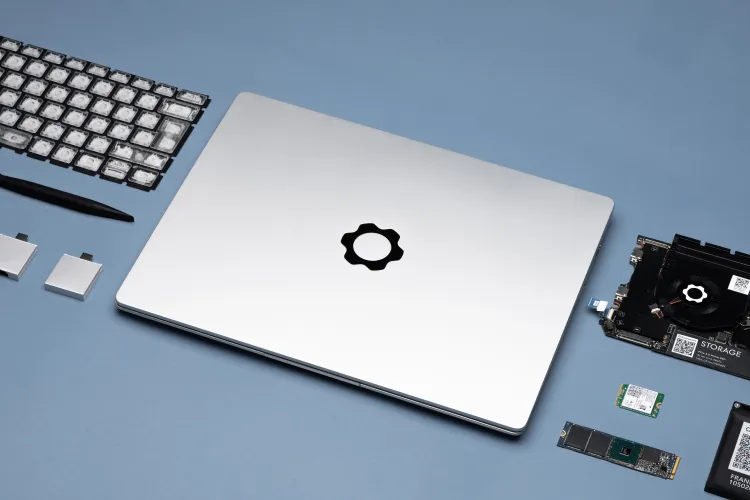In an era where consumer electronics often feel disposable, modular laptops are emerging as a game-changer, offering customizable parts and easy upgrades to extend device lifespan and reduce e-waste. Unlike traditional laptops with soldered components, modular designs allow users to swap out everything from RAM to motherboards with minimal effort. In 2025, brands like Framework, Lenovo, and Dell are leading the charge, driven by the right-to-repair movement and demand for sustainable tech. With the global laptop market projected to grow by 7% this year, modular laptops are gaining traction for their flexibility and eco-friendly appeal. This article explores how modular laptops work, top models to consider, their benefits for consumers, and the future of customizable computing.
What Are Modular Laptops?
Modular laptops are designed with interchangeable components that users can upgrade or replace without discarding the entire device. Unlike standard laptops, where parts like CPUs, GPUs, or batteries are often soldered or glued, modular laptops feature standardized, swappable modules—think of them as high-tech LEGO blocks. Components such as RAM, storage, Wi-Fi cards, ports, and even displays can be upgraded, repaired, or customized using simple tools like a screwdriver. This approach contrasts with ultra-thin models, like many 2-in-1 convertibles, which prioritize slimness over upgradability, as noted in industry discussions.
The concept isn’t new—desktop PCs have long been modular—but laptops face unique challenges due to their compact designs. In 2025, advancements in standardized interfaces and consumer demand for repairability are making modular laptops a viable alternative. Posts on X, like @New_Consecrated’s, highlight their potential to reduce e-waste by extending hardware lifespan, aligning with sustainability goals. For GadgetShaker readers, modular laptops mean a device that evolves with your needs, whether you’re a student, professional, or gamer.
Why Modular Laptops Matter in 2025
The rise of modular laptops addresses several pain points in consumer electronics:
- Longevity: Instead of replacing a laptop every 5–8 years, upgrading components like RAM or storage can extend its life to 10–15 years, saving money and resources.
- Customization: Users can tailor specs to their needs, from high-capacity storage for creators to powerful GPUs for gamers, as seen in Framework’s DIY kits.
- Sustainability: Modular designs reduce e-waste by allowing part replacements rather than full device swaps, a trend praised by @productpilotbb on X.
- Cost Efficiency: Upgrading specific components, like adding 32GB RAM for $100, is cheaper than buying a new $1,500 laptop, per Robots.net.
- Right-to-Repair: The movement, supported by companies like Framework, empowers users to fix devices themselves, reducing reliance on costly repairs.
For consumers, this means a laptop that grows with you, stays relevant longer, and aligns with eco-conscious values, all while leveraging the latest tech advancements.
Top Modular Laptops to Watch in 2025
Here are the standout modular laptops of 2025, selected for their upgradability, performance, and consumer appeal, based on industry updates and expert insights.
1. Framework Laptop 13 (AMD Ryzen AI 300 Series)
- Weight: 2.87 lbs (1.3 kg)
- Specs: AMD Ryzen AI 9 HX 375 (12 cores, up to 5.1GHz), up to 96GB DDR5 RAM, 2TB NVMe SSD, 13.5-inch 2.8K display (120Hz)
- Upgradability: Modular mainboard, RAM, SSD, Wi-Fi, battery, display, ports (USB-C, HDMI, etc.), and bezel colors
- Why It’s Exciting: Framework’s Laptop 13 is the gold standard for modularity, with every component swappable using a single screwdriver, per XDA Developers. Its DIY Edition lets you assemble it from scratch, and QR-coded parts link to replacement guides. @dhh on X calls it a “spiritual successor to ThinkPads” for its repairability. Priced at $899 (DIY) or $1,099 (pre-built), it’s ideal for tinkerers and eco-conscious users.
- Consumer Benefit: Upgrade the CPU or display years later, keeping your laptop future-proof without replacing it.
2. Framework Laptop 12
- Weight: 2.9 lbs (1.32 kg)
- Specs: AMD Ryzen AI 5 340, up to 48GB DDR5 RAM (single slot), 1TB M.2 2230 SSD, 12.2-inch 2.8K touchscreen (60Hz)
- Upgradability: Modular mainboard, RAM, SSD, Wi-Fi, battery, ports, stylus-supported touchscreen
- Why It’s Exciting: Launched in April 2025, this convertible offers stylus support and five two-tone color options (e.g., lavender, bubblegum), per Ars Technica. Its smaller motherboard limits RAM to one slot, but its modular ports and repairable design shine. The Verge notes its appeal for students and creators.
- Consumer Benefit: Perfect for artists or students needing a touchscreen laptop that’s easy to upgrade or repair.
3. Lenovo ThinkPad T14 Gen 5
- Weight: 3.03 lbs (1.37 kg)
- Specs: Intel Core Ultra 7 258V, up to 64GB DDR5 RAM, 2TB SSD, 14-inch 2.8K OLED
- Upgradability: RAM, SSD, Wi-Fi card, battery, keyboard
- Why It’s Exciting: Designed for business users, the T14 Gen 5 offers an easy-open chassis for upgrading RAM, SSD, and Wi-Fi, per XDA Developers. Its MIL-STD 810H durability and 14-hour battery life make it reliable. Windows Central praises its accessibility for upgrades.
- Consumer Benefit: Ideal for professionals needing a durable, upgradable laptop for long-term use.
4. Dell XPS 15 (9530)
- Weight: 4.21 lbs (1.91 kg)
- Specs: Intel Core i7-13700H, up to 64GB DDR5 RAM, 2TB SSD (dual slots), 15.6-inch 3.5K OLED
- Upgradability: RAM, SSD (two slots), Wi-Fi card, battery
- Why It’s Exciting: The XPS 15 combines a stunning OLED display with upgradable components, accessible by removing the bottom cover, per Digital Trends. Its powerful RTX 4060 GPU supports gaming and creative tasks. MakeUseOf notes its spare parts availability from Dell.
- Consumer Benefit: Great for creators or gamers wanting a high-performance laptop with upgrade flexibility.
5. HP ProBook 445 G11
- Weight: 3.04 lbs (1.38 kg)
- Specs: AMD Ryzen 7 8840U, up to 32GB RAM, 1TB SSD, 14-inch WUXGA display
- Upgradability: RAM, SSD (2.5” and M.2), battery, Wi-Fi card
- Why It’s Exciting: This business laptop offers commercial-grade performance and easy upgrades, with dual storage slots and long battery life, per Best Buy. @BestBuyUser on X highlights its value for upgradability.
- Consumer Benefit: Suited for hybrid workers needing a budget-friendly, upgradable laptop.
Benefits of Modular Laptops for Consumers
Modular laptops offer significant advantages for on-the-go users, professionals, and eco-conscious consumers:
- Future-Proofing: Upgrade CPUs, GPUs, or displays as new tech emerges, keeping your laptop relevant for a decade, as noted by PCWorld.
- Cost Savings: Replacing a $100 SSD or $150 RAM module is cheaper than a $1,500 new laptop, per Robots.net.
- Customization: Framework’s modular ports (USB-C, HDMI, etc.) let you tailor connectivity, while color options like lavender bezels add personality.
- Sustainability: By upgrading parts, you reduce e-waste, with Framework estimating 2,000 fewer laptops in landfills if 1,000 users adopt modularity for a decade.
- Ease of Repair: QR-coded components and open-source firmware, as seen in Framework’s designs, simplify DIY fixes, per Frame.work.
- Portability: Models like the Framework Laptop 12 (2.9 lbs) and ThinkPad T14 (3.03 lbs) remain lightweight despite modularity, rivaling ultra-thin laptops, as discussed in our ultra-thin laptops article.
For you, this means a laptop that adapts to your changing needs—whether upgrading storage for video editing or swapping ports for travel—while supporting sustainability.
Key Trends Shaping Modular Laptops in 2025
1. Framework’s Modular Ecosystem
Framework leads with its Laptop 13, 12, and 16 models, offering fully swappable components, including mainboards and graphics modules. The Framework Laptop 16 introduces modular GPUs (e.g., AMD Radeon RX 7700S), enabling gaming upgrades, per Frame.work. Its Expansion Bay and customizable input modules (e.g., RGB Macropad) set a new standard.
2. Intel’s Modular Architecture Blueprint
At CES 2025, Intel unveiled a reference design splitting motherboards into three modules (core, I/O left, I/O right), allowing CPU upgrades without replacing connectivity components. This blueprint, praised by Live Science, could inspire mainstream brands like Dell and Asus to adopt modularity, reducing e-waste.
3. Convertible Modularity
The Framework Laptop 12, with its 12.2-inch touchscreen and stylus support, brings modularity to 2-in-1 convertibles, a rarity due to their sealed designs, per Ars Technica. This appeals to creators and students needing tablet flexibility.
4. Mainstream Adoption
Lenovo’s Project Aurora and Dell’s Project Luna, previewed in 2024, introduce screwdriver-free designs, following Framework’s lead. These concepts signal growing industry interest in modularity, per The Verge.
5. Open-Source Support
Framework’s open-source firmware and QR-coded parts empower DIY enthusiasts, while Intel’s modular mini-PC designs extend customization to compact systems, per PCWorld.
Challenges and Considerations
Despite their promise, modular laptops face hurdles:
- Availability: Framework’s products are not widely available at retailers like Amazon, requiring direct orders, per Netbooknews.
- Cost: Modular laptops like the Framework Laptop 16 ($1,399+) can be pricier than non-modular alternatives, though long-term savings offset this, per MakeUseOf.
- Complexity: DIY assembly may intimidate novices, though Framework’s guides simplify the process, per Frame.work.
- Limited Mainstream Options: Beyond Framework, only select models (e.g., ThinkPad T14, XPS 15) offer partial modularity, per Windows Central.
- Privacy: AI-driven features in modular laptops (e.g., performance optimization) collect data, so review settings, as noted in our GDPR Policy.
GadgetShaker recommends checking manufacturer guides for upgrade processes and ensuring your technical comfort level aligns with DIY requirements.

The Future of Modular Laptops
By 2030, modular laptops could dominate 20% of the market, driven by:
- Standardized Interfaces: Intel’s blueprint may unify modular designs across brands, per Live Science.
- 6G Integration: Faster connectivity, as discussed in our 5G article, will enhance cloud-based upgrades.
- AI Optimization: Next-gen processors, like Intel’s Panther Lake, will streamline modular performance, per our processors article.
- Eco-Friendly Designs: Recycled materials and modular mini-PCs, like Framework’s Desktop, will reduce e-waste, per Tom’s Guide.
For consumers, expect laptops that last a decade, with plug-and-play upgrades for CPUs, GPUs, and displays, making them as versatile as desktops.
GadgetShaker’s Commitment
At GadgetShaker, we test modular laptops to deliver insights you can trust. Curious about the Framework Laptop 12 or ThinkPad T14? Share your thoughts on our Contact Us page or comment below! Stay tuned for articles like “Best Modular Laptops for 2025” or “How to Upgrade Your Laptop Like a Pro.”

